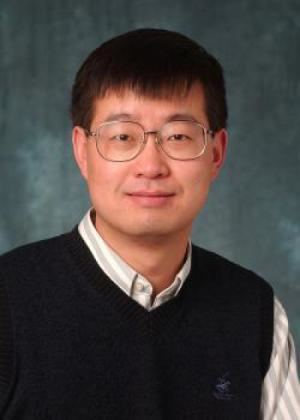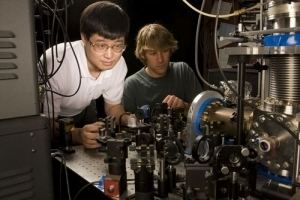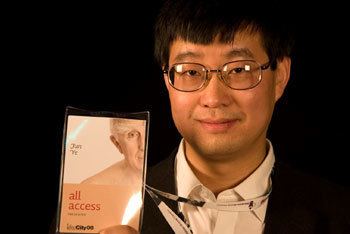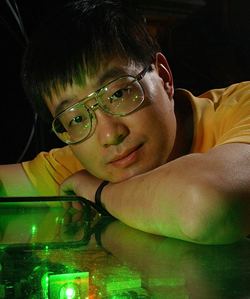Name Jun Ye | Doctoral advisor John L. Hall | |
 | ||
Notable awards Department of Commerce Gold Medal (2001, 2011, 2014)Arthur S. Flemming Award (2005)Carl Zeiss Research Award (2007)William F. Meggers Award (2007)I.I. Rabi Prize in Atomic, Molecular or Optical Physics (2007)Elected to the National Academy of Sciences (2011)Presidential Rank Award (2015) Institution National Institute of Standards and Technology, JILA, University of Colorado Boulder Similar Eric Allin Cornell , John L Hall , H Jeff Kimble Born 1967 (age 52–53) Shanghai, China | ||
Jun ye let there be light and thus time darpa wait what
Jun Ye (born 1967) is a Chinese-American physicist at JILA, National Institute of Standards and Technology, and the University of Colorado at Boulder, working primarily in the field of atomic, molecular and optical physics.
Contents
- Jun ye let there be light and thus time darpa wait what
- Jun ye at technion quantum matter for metrology and many body physics
- Education Career
- Research
- Honors and awards
- References

Jun ye at technion quantum matter for metrology and many body physics
Education & Career

Jun Ye was born in Shanghai, China, shortly after the Cultural Revolution. His father was a naval officer and his mother an environmental scientist. He was primarily raised by his grandmother. Ye graduated with a bachelor's degree in physics from Shanghai Jiao Tong University in 1989. He then moved to the United States to commence graduate studies, completing a master's degree at the University of New Mexico under Marlan Scully in theoretical quantum optics in 1991. He also gained experience in experimental physics under John McInerney working on semiconductor lasers, and spent a summer at the Los Alamos National Laboratory.

Ye then went to Boulder to begin a Ph.D. in physics. He was accepted as the last graduate student of eventual Nobel Prize laureate John L. Hall. His thesis was on high-resolution and high-sensitivity molecular spectroscopy, which he completed in 1997. He then moved to California Institute of Technology as a Milikan Postdoctoral Fellow, working under Jeff Kimble.

Jun Ye moved back to Boulder and JILA as a JILA Associate Fellow and NIST physicist in 1999. John Hall donated most of his lab space to him. He was promoted to full Fellow in 2001 and has been there since, establishing a research program in AMO physics and precision measurement.
Research

Jun Ye's research focuses on ultracold atoms, ultracold molecules, and laser-based precision measurement. His group has built an optical atomic clock using strontium trapped inside an optical lattice, which (in 2015) is the most precise clock in the world, having a frequency uncertainty of 2.1 × 10−18. This is the equivalent of a variation of less one second than in 15 billion years - a period longer than the age of the universe. Such a clock could potentially be used for research into variations in the Earth's gravitational field, searching for particles of dark matter, performing quantum simulations of many-body physics, and investigating the fundamental nature of light and matter. He also conducts research on strontium for experiments in quantum information science (collaborating with Mikhail Lukin, Ana Maria Rey, Peter Zoller, and others).
Ye's other research focuses include ultrastable lasers (which are essential for the mechanics of his atomic clock), frequency combs, and molecular spectroscopy. In 2012, his group successfully constructed the world's stablest laser. He pioneered the development of direct frequency comb spectroscopy, and also collaborates with Eric Cornell on an experiment aiming to measure the electric dipole moment of the electron using trapped ions.
Honors and awards
Jun Ye has received numerous awards in the field of science, particularly AMO physics. He was elected a Fellow of the American Physical Society and a Fellow of the Optical Society of America. He won the Adolph Lomb Medal of OSA in 1999 and the Arthur S. Flemming Award for outstanding federal employees in 2005, the Friedrich Wilhem Bessel Research Award from Germany and the William F. Meggers Award of the Optical Society of America in 2006, and the Carl Zeiss Research Award and the I.I. Rabi Prize in AMO Physics from the APS in 2007. He has won three Gold Medals from the US Department of Commerce: for frequency combs (2001), ultracold molecules (2011), and atomic clocks (2014). In 2011 he was elected to the National Academy of Sciences, and also named a Frew Fellow from the Australian Academy of Science. In 2015, President Obama selected Jun Ye to receive a Presidential Rank Award for “sustained extraordinary accomplishment”, citing his work advancing "the frontier of light-matter interaction and focusing on precision measurement, quantum physics and ultracold matter, optical frequency metrology, and ultrafast science."
He is one of the most highly-cited researchers in experimental atomic physics in the world, having a h-index of 85 and being regularly named as a Thomson-Reuters (ISI) Highly Cited Researcher.
